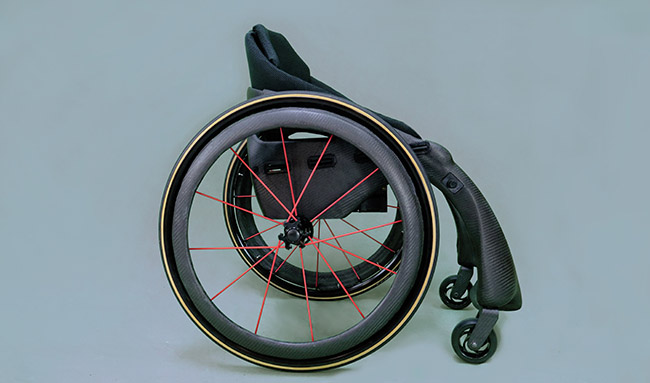 EVER since breaking his back as a young teenager Andrew Slorance dreamed of designing a wheelchair that would change people’s perceptions.
EVER since breaking his back as a young teenager Andrew Slorance dreamed of designing a wheelchair that would change people’s perceptions.
Now 51-year-old Andrew is living that dream, thanks to winning a sensational $1m (£740,000) competition.
Andrew, who runs the Phoenix Instinct company in Scotland, scooped the top prize in the Toyota Mobility Foundation’s $4m global competition that aims to find new ways to improve the mobility and independence of people with lower limb paralysis.
“I broke my back after falling from a tree when I was 14,” says Andrew, from Nairn, near Inverness.
“I remember lying in the hospital bed in Aberdeen and an occupational therapist came in and she wheeled a wheelchair up to my bed.
“She said, ‘Andrew, I’ve got your new wheelchair for you. I hope you will agree it’s rather a nice example’.
“I looked at this thing and I thought: ‘You’ve got to be kidding right?’ The first day I went out in that wheelchair was without doubt the worst day of my life.
“I felt completely immobilised because the thing was so big… I suddenly realised everybody was looking at me in a way people had never looked at me before.”
Two years later, Andrew decided that one day he would design a chair that would change perceptions by using cutting edge materials and styling.
In the meantime, he has been a TV producer for ITV, Channel 4 and Sky before becoming an inventor.
He and wife, Mary, remortgaged their home to start his company.
“I knew the next step beyond advanced materials has to be to make wheelchairs smart.
“But that costs a huge amount of money in development. So, when I saw this Challenge, I thought here is the money to develop this technology.
“No-one else is going to do it. No company is going to decide to spend half a million dollars on research and development to advance the manual wheelchair. Why should they?
“As long as their competitor also doesn’t do it the status quo can continue with wheelchairs remaining much as they were thirty-five years ago.
His revolutionary Phoenix Ai wheelchair overcomes the primary cause of accidents for wheelchair-users – tipping over backwards.
“This happens because the wheelchair has a fixed centre-of-gravity, but the user doesn’t,” Andrew explained.
“If the user moves too far out of sync with the fixed position of the wheelchair, they’re going to fall over.”
One way to deal with this is by having the axle to the back of the wheelchair and putting the user’s weight to the front of it – but this brings new challenges.
When the weight is carried by the small front wheels, this adds drag, making pushing and turning much more difficult, and introducing uncomfortable vibrations that can cause pain and muscle spasms.
Wheelchair designs have previously had to make a trade-off between agility and stability, but Andrew’s ultra-light, stable carbon fibre design allows the wheelchair to automatically change the weight distribution itself, keeping users balanced while also ensuring they’re as agile as possible.
“The wheelchair as we know it has been technologically unchanged for decades.
“Your wheelchair is the world’s first perception of you. If that thing looks awesome and hi-tech, that puts forward a positive perception.
“We live in a time when our fridge freezer can be smart, it can tell us the milk we put in has gone out of date.
“Yet the wheelchair is the thing you actually need every day of your life… and it’s still got the technology from 1984. This is a game changer.”
The other finalists, who have all received a share of the total prize money, include a powered exoskeleton called Quix, designed by researchers from IHMC & MYOLYN the US.
Another American team reached the finals for their Evowalk simulator, a wearable that goes below the knee and uses AI to support users’ muscles and help people going through rehabilitation for walking.
A third finalist called Qolo (Quality of Life with Locomotion), from the University of Tsukuba in Japan, is a standing mobility device that integrates exoskeleton and wheelchair functions, supporting users to stand and sit with a passive assist mechanism for people with lower limb paralysis.
The fourth finalist, called Wheem-i, and designed by Italian team Italdesign, is a wheel-on semi-autonomous electric device that provides ride sharing for wheelchair users.
Sir Philip Craven, member of the board of directors at Toyota and former president of the International Paralympic Committee, said: “Mobility means freedom. It means liberation from being limited in life.
“As we believe at Toyota, when we are free to move, we are able to fully participate in society, and I’m excited for each of these devices supported by the Mobility Unlimited Challenge, particularly the winning device, because of how it will allow so many people to better do what they want to do.”
- Around the world, millions of people are living with lower-limb paralysis (the most common causes being strokes, spinal cord injury and multiple sclerosis). While there are no statistics on paralysis worldwide, the World Health Organisation estimates there are 250,000-500,000 new cases of spinal cord injury globally every year.
 ANDREW’S Phoenix AI wheelchair is an ultra-lightweight manual wheelchair made from carbon-fibre.
ANDREW’S Phoenix AI wheelchair is an ultra-lightweight manual wheelchair made from carbon-fibre.
Using smart sensors the chair will configure itself to what the user is doing so it remains in sync with how the user moves.
The sensors detect if the user is leaning forward or back, algorithms will calculate the wheelchair’s response.
Intelligent, lightweight power assist will make slopes easier to ascend while automatic braking will remove the need for users to grip the wheels to slow down.

